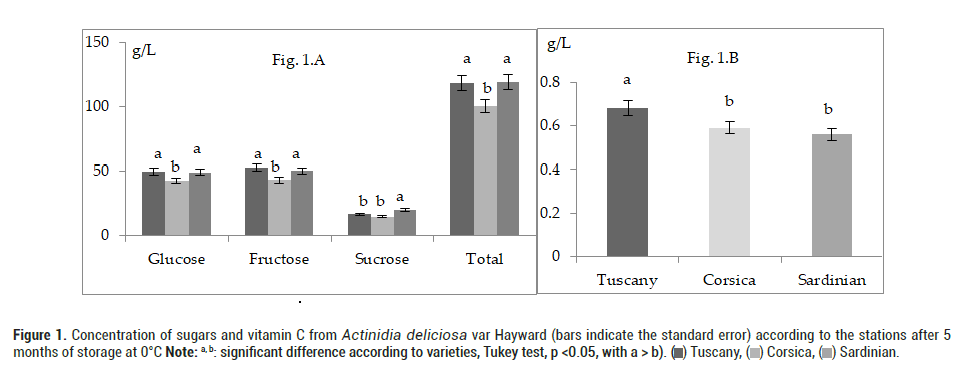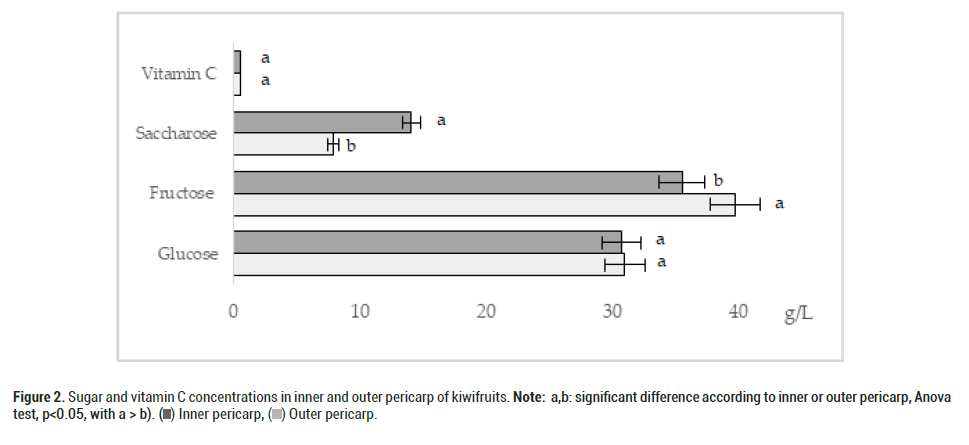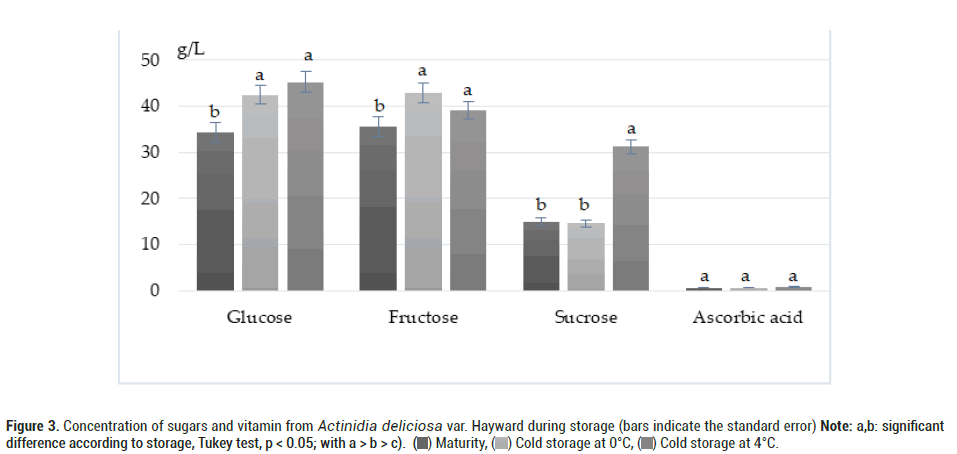Research - (2023) Volume 12, Issue 5
In this study, the effects of storage, geographic origin, and distribution of sugars and vitamin C in kiwifruits were examined. Analyses were carried out using an HPLC-DAD system. The main sugars in Hayward and Kramer varieties of kiwifruits were fructose (34.8 and 41.1 g/L) and glucose (35.2 and 40.3 g/L), respectively. The sugar concentrations were higher in Hayward compared to the Kramer variety. Ascorbic acid concentrations were measured to be around 0.6, and there were no significant differences between Hayward and Kramer varieties. We demonstrated that the concentrations of sugars and vitamin C varied depending on the geographic origin of the samples. These compounds' concentrations were higher in the Sardinia and Tuscany regions compared to Corsica, suggesting that abiotic and biotic factors can influence the organoleptic characteristics of the product. We also observed that sugars and vitamin C were more concentrated in the outer part of the kiwifruits than the inner part. Lastly, kiwifruits appeared to be better preserved in a chamber at 0°C than at 4°C.
Kiwifruit • Storage • Sugars • Vitamin C
The Actinidia genus (Actinidiaceae family) comprises approximately 50 species that originate from southwest China. Kiwifruit is a classic climacteric fruit, and the optimal storage conditions vary depending on the species [1]. Kiwi trees, belonging to the aforementioned family and genus, are dicotyledonous sub-shrubs (height: 1-3 m) with white flowers (blooming period: June to July) that grow naturally in Corsica (altitude: 0-600 m) [2]. They are primarily cultivated in New Zealand, Australia, California, and the Mediterranean basin [3,4]. Kiwifruit production is a thriving agricultural activity in Corsica, accounting for up to 10% of the total French production [5,6]. The ability to determine the optimal harvesting time based on the desired storage duration represents valuable commercial knowledge [7,8]. Fruit storage significantly impacts its quality, particularly its organoleptic properties. Kiwifruits can be harvested when they are physiologically mature but not fully ripe, as they continue to ripen during storage. However, if harvested too early or when almost ripe, they quickly soften during storage, which is undesirable [9]. Rotting during this period leads to substantial economic losses. The typical storage period for fresh kiwifruits in the market is about 4-6 months [10,11], and it is presumably related to the onset of starch hydrolysis and the accumulation of soluble sugars in the fruit [12].
Kiwifruit contains significant amounts of acids, sugars, vitamins, polysaccharides, and minerals [13]. Investigating the composition and sugar concentrations in kiwifruits is crucial for assessing their quality. It is also relevant to analyze organic acids and phenolic compounds, as they can influence the fruit's organoleptic characteristics. The balance between soluble sugars and non-volatile organic acids plays a major role in determining the flavor of the fruit flesh [14]. Other factors such as storage conditions, climatic elements, and the physiological stage at harvest also influence the physical and sensory properties of kiwifruits and recent studies on kiwifruit storage have focused on various aspects aimed at improving quality and extending the shelf life of these delicate fruits [15-17].
The main sugars found in kiwifruits are glucose, fructose, and sucrose [18]. In recent years, there has been growing interest in kiwifruit production due to its high antioxidant capacity [19]. Kiwifruit is also widely recognized as an excellent source of vitamin C [20]. Hayward is the reference variety and the most commonly cultivated one, producing large fruits with tangy flesh. They can be harvested from November to January. On the other hand, the Kramer variety is less well-known and described, but new varieties hold significant economic potential and could exhibit diverse and interesting characteristics such as fruit and flesh color, flavor, skin texture, fruit size, resistance to pests and diseases, and length of the harvest period.
The objective of this study is to assess the concentrations of sugars and vitamin C in the Hayward and Kramer varieties, evaluate the impact of storage and geographic origin on these parameters, and analyze the distribution of sugars and vitamin C within the kiwifruit.
Plant material
Kiwifruits of the Hayward and Kramer varieties (Actinidia deliciosa var. Hayward and var. Kramer) were collected from a plantation located in San Giuliano, Corsica, France (42° 17' N, 9° 32' E). The units were selected randomly. The soil pH in the plantation was measured at 6.30, and the trees were seven years old. Microjet irrigation was employed. A total of 150 units of each variety were harvested on November 15th when they reached maturity.
After sampling, the kiwifruits were placed in an icebox to maintain their freshness during transportation to the laboratory. In the laboratory, half of the fruits were used immediately for the analysis of sugars and ascorbic acid. The remaining 75 fruits were divided into two groups, with 40 fruits stored in a chamber at 0°C and 35 fruits stored in a chamber at 4°C for a duration of 5 months. The hygrometry levels were maintained between 90% and 95%.
Kiwifruits from Tuscany and Sardinia were collected from plantations in these regions. Fifty units of the Hayward variety were harvested at maturity on November 15th. The soil pH in Tuscany and Sardinia was measured at 6.7 and 6.9, respectively, and the trees' ages were 10 and 15 years, respectively. Microjet irrigation was also utilized in these plantations. The Tuscany and Sardinia kiwifruits were directly processed into juice for the analysis of sugar and ascorbic acid concentrations at maturity.
The kiwi juice was extracted using a rotor machine and filtered through a series of steps, including centrifugation, Buchner funnel filtration, and a final filtration through a 0.45 μm membrane. Various analyses of sugars and ascorbic acid were conducted at maturity based on the following factors: i) kiwifruit varieties, ii) geographic origin of the units, iii) inner and outer parts of fruits (for the Hayward variety), and iv) temperature storage after five months. The analysis of sugars and vitamin C was performed using High-Performance Liquid Chromatography (HPLC) coupled with a Diode Array Detector (DAD). Each analysis was performed in five replicates.
HPLC system analysis
A Perkin-Elmer 200 series system consisting of a binary pump (LC 200), an injector (20 μL injection loop) and a degasser (series 200) was employed. For sugars characterization, analyses were carried out on an Aminex HPX 87C (Biorad, France) column (300 mm × 7.8 mm; particle size 9 μm) eluted isocratically with 100% water (Milli Q) at a flow rate of 0.6 mL.min-1 for 20 min. The oven temperature was set at 85°C. Detection was performed on refractometer detector (LC 200). The analysis of ascorbic acid was made using an Aminex HPX 87H (Biorad, France) column (300 mm × 7.8 mm; particle size 9 μm) eluted isocratically with 100% water/ sulfuric acid (0.008 N) at a flow rate of 0.6 mL.min-1 also for 20 min. Oven temperature was set at 35°C. Detection was performed at a wavelength of 245 nm by a Diode Array Detector (DAD LC 200).
Chemicals and standard solutions
Glucose, fructose, sucrose, and ascorbic acid standard compounds were acquired from Sigma-Aldrich (France). External calibrations were carried out for each compound analyzed in this study using the aforementioned apparatus. Calibration curves were established using a minimum of five data points. Linear regression analysis was performed for each calibration curve, and the determination coefficients (R2) ranged from 0.989 to 0.995, indicating excellent repeatability of the system.
Statistical analysis
Significant differences for statistical analysis were determined using one-way Analysis of Variance (ANOVA). ANOVA was employed when the necessary conditions were met, namely, the normal distribution of means and homogeneity of variances between means, as determined by the Shapiro-Wilk test and Bartlett test, respectively. Differences were considered significant when p<0.05. Whenever a significant difference was detected, Tukey's HSD post-hoc comparison technique was applied to identify which groups were statistically distinct. The Pearson Test was utilized to examine the correlation between two variables. The same statistical tests were employed for analyzing this dataset [21].
The sugars (fructose, glucose, and sucrose) and vitamin C in the kiwifruits were isolated and quantified using HPLC-DAD. The concentrations of sugars in extracts from ripe Hayward and Kramer fruits were as follows: 34.8 g.L-1 and 41.1 g.L-1 for fructose, 35.2 g.L-1 and 40.3 g.L-1 for glucose, and 19.8 g.L-1 and 16.3 g.L-1 for sucrose, respectively. Glucose and fructose were found to be the predominant sugars in both varieties of kiwifruits, while sucrose was present in a much smaller proportion. These findings are consistent with previous studies [17,18,22]. The total sugar concentrations in the samples at maturity (including sucrose, fructose, and glucose) ranged from 86.4 ± 4.5 g.L-1 to 101.2 ± 5.8 g.L-1 for Hayward and Kramer, respectively. Our study indicates significant differences between the two varieties, with higher sugar concentrations observed in extracts from Hayward kiwifruits (Table 1, ANOVA, p<0.05). The lower total sugar content in Kramer kiwifruit extracts may contribute to their reduced commercialization compared to the other variety. Additionally, the concentration of ascorbic acid was determined and showed variations ranging from 0.57 ± 0.02 g.L-1 to 0.58 ± 0.02 g.L-1 for Hayward and Kramer, respectively. There were no significant differences between the two varieties in terms of ascorbic acid concentrations. However, substantial variations in sugars were observed, which can be attributed to factors such as ripeness, storage methods, and growing conditions [23].
|
Glucose |
Fructose |
Sucrose |
Total sugar |
Ascorbic acid |
Kramer |
35.2 ± 1.06a |
34.8 ± 1.04a |
16.3 ± 0.50a |
86.4 ± 4.50a |
0.58 ± 0.02a |
Hayward |
40.3 ± 1.21b |
41.1 ± 1.24b |
19.8 ± 0.60b |
101.2 ± 5.80b |
0.57 ± 0.02a |
Note: a,bsignificant difference according to varieties, Anova, p<0.05).
Table 1. Concentration of sugars and ascorbic acid (g.L-1) from Actinidia deliciosa var. Kramer and Hayward.
The sugars concentration is significantly impacted by the geographic origin of harvested samples. We observed that the sugars concentration in fruit flesh is higher in Sardinia and Tuscany regions than in Corsica (Figure 1, Tukey test p<0.05). These contents are affected by environmental and cultivation practices (e.g., temperature, light intensity, cultivar, rootstock, mineral nutrition, water availability and maturity degree) [24]. These differences on the sugar and vitamin C contents according to the sampling locations can be linked to these conditions. Another example showed conventionally grown fruit also had greater soluble solids, fructose and glucose contents than the other kiwifruits [25]. Glucose and fructose concentration is 49.3 ± 0.5 g.L-1 and 51.2 ± 1.7 g.L-1 for the two regions, 42.5 ± 0.7 g.L-1 and 43.0 ± 0.5 g.L-1 in Corsica. Sucrose concentration is superior in Sardinia (p<0.05). Vitamin C is more important in Tuscany originated kiwifruits (p<0.05). There is no significant difference in the concentration of vitamin C from Sardinian and Corsican kiwifruits (p>0.05).
Analysis of sugars and ascorbic acid in inner part and outer part from Hayward kiwifruit
The quality of kiwifruit is very much related to its sugar content; we investigated the distribution of sugars in the whole fruit (Figure. 2). Fruits have two main parts, with one corresponding to the internal part of the pulp containing the seeds (inner part), and the other representing the outer part with the pulp between the epidermis and the inner part. The results shown on Figure 3 indicate that glucose and ascorbic acid is homogeneously distributed in the kiwifruit. Indeed, there is no significant difference between the inner and outer part of the kiwifruit (Figure 3, (p<0.05)). The same results were observed by Selman for total vitamin C concentrations with the same concentration in the skin, the outer pericarp and the inner pericarp [23]. However, we observe significant differences in the content of fructose and sucrose in kiwifruit (p<0.05). The outer part of the fruit has a higher concentration of sugars. Our results are similar with those reported in the literature [23]. Burdon et al., showed a higher glucose and fructose concentration in the outer pericarp than the inner pericarp [26]. However, for valorization of kiwifruit, it doesn’t seem necessary regarding sweetness (quality criteria) to segregate the different parts of the fruit.

Figure 1. Concentration of sugars and vitamin C from Actinidia deliciosa var Hayward (bars indicate the standard error) according to the stations after 5
months of storage at 0°C
Note: a, b: significant difference according to varieties, Tukey test, p <0.05, with a > b).  Tuscany,
Tuscany,  Corsica,
Corsica,  Sardinian.
Sardinian.
 s
s
Figure 2. Sugar and vitamin C concentrations in inner and outer pericarp of kiwifruits.
Note: a,b: significant difference according to inner or outer pericarp, Anova
test, p<0.05, with a > b).  Inner pericarp,
Inner pericarp,  Outer pericarp.
Outer pericarp.

Figure 3. Concentration of sugars and vitamin from Actinidia deliciosa var. Hayward during storage (bars indicate the standard error)
Note: a,b: significant difference according to storage, Tukey test, p < 0.05; with a > b > c).  Maturity,
Maturity,  Cold storage at 0°C,
Cold storage at 0°C,  Cold storage at 4°C.
Cold storage at 4°C.
Evolution of sugars and vitamin C during storage (cold storage at 0°C and 4°C)
The ability to assess the optimal time for harvest in accordance with the desired duration of storage is of considerable commercial value. Sugars concentrations increased with storage time until 5 months (Figure 3 p<0.05). The same results were reported by Barboni, et al. [5]. We observed that the concentration of total sugars is greater when the kiwifruit is stored at 4°C than at 0°C (p<0.05). The storage temperature influenced on the storage time. But this difference is not the same according to the separate sugars. Glucose and fructose concentrations were higher after 5 months of storage in comparison of their concentrations at maturity, but there isn’t significant difference between the storage at two temperatures (p>0.05). The cold allows the fruits to keep longer. This is due to the enzymes found naturally in the fruits. These become less active, or even inactive, at temperatures below 3°C or 4°C. However, these enzymes allow the fruit to ripen. Thus, the cold slows down the ripening metabolism. The difference observed is on the sucrose concentration where it is greater when the kiwifruit is placed at 4°C for 5 months (p<0.05). The time and the method of storage (0°C or 4°C) affect the organoleptic quality and thus the commercial interest of the kiwifruit. We observed the ascorbic acid concentration is not statistically different (p>0.05) when the fruit is at maturity or when the fruit is stored at 0°C for 5 months. Inversely, its concentration is greater under storage condition at 4°C (p<0.05). Tavarini, et al. examined the change in vitamin C according to the stage of maturity of kiwifruit [27]. Generally, fresh fruits contain more vitamin C than those cool stored [28].
To conclude, in this study, HPLC-DAD was applied for the analysis of sugars and organic acids present in kiwifruit. After measuring the sugars, it was observed that fructose and glucose are the predominant sugars found in kiwifruits. We observed that geographical origin plays a significant role, with Italian kiwis exhibiting higher sugar content compared to kiwis from Corsica. In terms of ascorbic acid levels, they were found to be higher in Corsican kiwifruits. Furthermore, our study demonstrated that both sugar and ascorbic acid are uniformly distributed throughout the kiwifruit (both inner and outer parts). Finally, sugar concentrations increased over storage time, and the storage method (0°C or 4°C) appeared to impact the organoleptic quality and overall quality of the kiwifruit.
The authors thank the « collectivité de Corse » for funding this study.
Citation: Barboni, T., et al. Characterization of sugars from Hawyards and Kramer Kiwifruits: Influence of storage, geographic origin, distribution of sugars and Vitamin C in the Kiwifruit. J Biol Todays World, 2023,12(5), 001-004
Received: 07-Aug-2023 Editor assigned: 11-Aug-2023 Reviewed: 25-Aug-2023 Revised: 01-Sep-2023 Published: 08-Sep-2023, DOI: 10.35248/2322-3308-12.5.001
Copyright: © 2023 Barboni T, et al. This is an open-access article distributed under the terms of the Creative Commons Attribution License, which permits unrestricted use, distribution, and reproduction in any medium, provided the original author and source are credited.